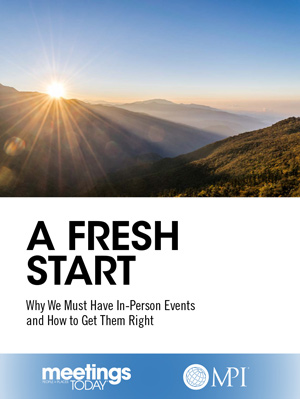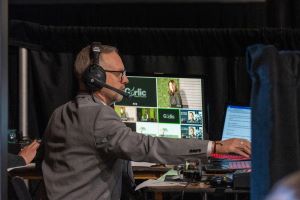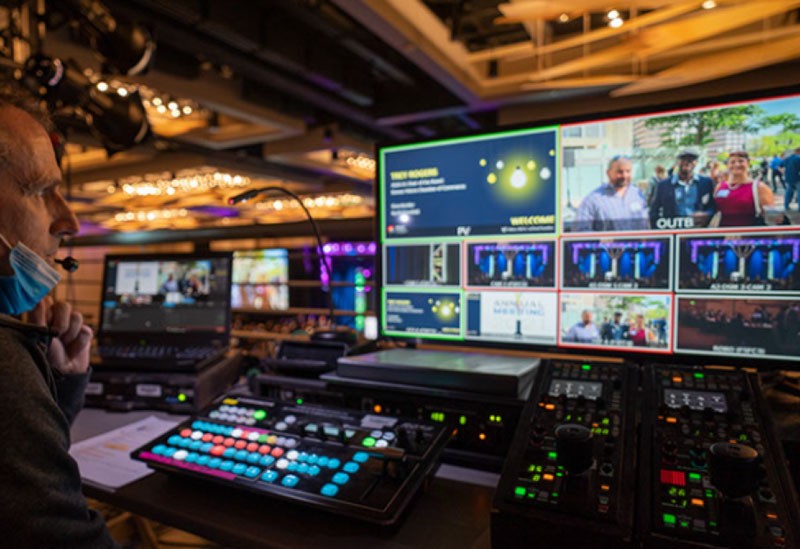The thought of having to add hybrid meetings to the skill set of planning meetings can cause great consternation for planners, but the consensus is that adding a virtual component to in-person meetings will become an industry standard of sorts moving forward.
An individual or small team of planners can’t realistically manage the staggering logistics required to produce an in-person as well as simultaneous virtual program. Hybrid meetings, in many cases, require nearly a duplicate level of staffing.

[Download the Rest of Our FREE Fresh Start eHandbook]
Even at the highest end, hybrid event production companies certainly come to the party loaded to bear, but still have strategies to contain costs.

“We just did a large in-person conference with nine concurrent session rooms. Not every session was webcast, and only a few speakers had to be Zoomed in to the ballroom and onto the webcast,” said Mary Ann Pierce, founder and CEO of Map Digital, a pioneer in virtual events that counts many global financial institutions—a segment heavy with regulations—as clients. “Thankfully, everything was on the MetaMeetings platform, from onsite registration with CLEAR authentication, digital agenda signage, speaker-ready, and the same conference website for in-person and web attendees, whether the session was webcast or not. So, the integration of services provides a compression of budget P&Ls [profit and losses] and onsite labor. Our MAP team built the networks and stations, and then put on business suites to run the onsite work.”
Pierce imparted the following key pieces of advice for planners jumping into the world of hybrid meetings.
“First thing: long-term thinking. Partner with tech [companies] and have an integrated tech stack,” she advised. “Even our big bank clients are looking to cut costs. So, we compress labor costs by interconnecting into their internal databases to cut down workflow and to push data in real-time. We also interconnect with their other tech platforms, so that users have only one login on our MetaMeetings website.
“Hybrid is labor-, tech- and equipment-intensive, and, not to tattle, but hotels and staging vendors are short-staffed with less-experienced teams,” she shared. “We all need to take more time in preproduction and not assume that everyone will hit their mark like in 2019. If staging falls down, we can’t build our systems. We are all in this together.”
[View Our FREE On-Demand Mary Ann Pierce Webinar: How to Repurpose Event Content to Build Communities, Generate Leads and Enhance Revenue]
According to Pierce, very basic levels of hybrid meetings can be described as follows:
Good is using existing cameras to do simple broadcasts of sessions. (Unions can be an issue here, but we have a webcast in a box solution with a camera and/or BirdDog robotic camera—pricey but cuts down on onsite labor, which is, again, a union issue.)
Better would be the above, plus more engagement and multiple sessions, etc. Best would probably be more in line with what we do.
In that spirit of classification, we checked in with some additional hybrid meetings experts to get their opinion on various levels of complexity and cost, with the intent of getting planners to wrap their minds around this demanding new aspect of their jobs and not be afraid to dive into that proverbial pool and start swimming.
[Check Out Our Other FREE eHandbooks!]
Good Hybrid Events

According to Sarah Soliman, president and CEO of Soliman Productions—you may have seen her onsite producing hybrid components of major industry shows such as MPI’s WEC—there are a number of ways to produce a hybrid component without breaking the bank.
“There is a common misconception that hybrid meetings are expensive, but it’s about how creative you can get with the space and opportunities that hybrid events present,” said Soliman, who is adept at producing hybrid programs in all ranges of expense and complexity.
A key strategy is to be very selective about what specific components of the in-person meeting you want to include in the hybrid program.
“Cross-reference your agenda with your meeting space and identify the sessions that are most important to stream,” she advised. “The way you identify those is to measure which content has the most long-term value for on-demand use. I typically suggest streaming two sessions. Use your general session/plenary ballroom as room number one to stream all of the big events, like keynotes, awards, etc. Then, repurpose that same ballroom for some of your most popular breakout sessions that you plan on live streaming. Your second room can be a smaller breakout room.”
Having only two rooms where your onsite production team is set up in will save a lot of money, Soliman added.
[Related: 6 Ways to Save on Hybrid Meeting Production Costs]
Also, remember that, like a traditional in-person event, the organization you’re planning for doesn’t have to bear the entire cost of the hybrid production effort.
“I recommend finding a sponsor to be your ‘exclusive hybrid sponsor’ to help offset the cost,” she said. “They can support your virtual platform with tons of branding and content opportunities throughout the event, in addition to sponsoring your internet for the live stream component onsite.”
Keeping the number of vendors you work with to a minimum is also a money-saving strategy.
“I am always a fan of working with one vendor who can provide both the platform and the onsite production, as this tends to save cost, too,” she added. “Most companies will bundle pricing should you work with them on all fronts.”

And don’t consider the hybrid component a “one and done” affair.
“There is also an opportunity to generate additional revenue by building a content library post-event where the recordings would live and be accessible for an added cost throughout the year,” she pointed out. “Hybrid presents many opportunities to generate new revenue streams.”

Eric Newkirk, president of RSN, a North American network of premier AV companies, and vice-president design and creative at CEAVCO Audio Visual, is experienced with hybrid events throughout the cost/complexity spectrum.
“I feel like a lot of planners are already doing a lot of things that could be easily leveraged as a hybrid experience,” he said. “Planners say, ‘Hey, we have cameras in the room to make sure the cheap seats don’t feel like the cheap sets.’ Leveraging that to provide a recording that can be uploaded to the internet by the end of the day is low-hanging fruit. AV companies should be prepared to turn that around at the end of the day, or in the worst-cast scenario, a few days after the end of the conference.
“If the stakes are higher and you have a larger online audience, yes, you should have a much more sophisticated online product,” he continued. “But for smaller [audiences], it will take maybe an hour or two to get an hour-long session ready to post.”
Newkirk also recommends leveraging your relationship with your AV company when it comes to selecting an online platform provider, as they may have existing relationships that are helpful.
Of course, planners can go the bare-bones route and stream through YouTube, Facebook and the like, but that can result in the loss of control over what else shows up on that feed.
[Related: What Are Hybrid Events—Really?]
“It’s kind of the wild, wild west—ads that stack up and interruptions to the content,” he said. “For some groups that may not be that big of a deal, but for an on-demand version of an event, we don’t have a lot of groups that are interested in that. It might be simulcast to that platform, but it’s rarely the ticketed experience.
“It’s hard to imagine viewers sitting down and watching an hour’s worth of material, so we’re convinced the online audience requires a completely different approach,” he added. “I think the thing that makes it more of an event is the interactivity. If you’ve recorded something that happened in person, you need to interact with that audience—some Q&A, chat…some activity that keeps that online activity engaged.”
Better Hybrid Events
Upping the ante a bit means creating much more interactivity and engagement with the online audience, and the best way to do that is to create specific content just for it.

“There are sessions that strictly involve remote participants; there isn’t a stage, there isn’t a number of people in a live audience that are a part of it—there’s not an us vs. them. You essentially will be dividing your audience,” Newkirk said. “That middle-road budgetary approach works because you can leverage a lot of the content from the in-person event and apply it to the virtual audience. That could be a keynote that’s recorded in person and played back to the virtual audience, and then you have sessions that would reference that keynote—whether it’s on Zoom or the platform itself—to get audience members to interact with each other. A moderated experience talking about the content to a virtual audience is a very effective way to do it. Maybe have a keynote speaker joining remotely to do a Q&A. Add to the contract a one-hour session with an interactive Q&A session for the virtual audience.”
Newkirk said that the live component of this secondary virtual experience is akin to roundtables and breakout sessions where people can contribute on an individual basis.
“It’s not a great environment for the one to many,” he said. “You stream out the content and you have sessions about that content to up the engagement factor. I think what an audience member in a virtual experience would like to do is engage other people, so have a series of sessions and take the content and make it relevant to a smaller group of people it’s more relevant to.”
The Best Hybrid Events
The crux of the hybrid experience takes its cues from the broadcasting world. Think the Oscars broadcast, or major sporting events in which the in-person experience and home-viewer experience are similar but also very different in some key aspects.
“The approach to that that works very well is you’ve got a dedicated team of production professionals that are above and beyond your AV team,” Newkirk said. “It’s very much more of a production-centric environment, and they’re running it like coverage of a news event. They’re seemingly in all places at once, and essentially filing stories and making it relevant to that online audience in real time.”
This first-class experience, of course, will entail significant costs—it’s essentially an entire second meeting being run concurrently with the in-person event, and will suck up major venue bandwidth in order to deliver a high-quality show to the audience.
“During the pandemic, a lot of facilities upgraded their connectivity offerings,” Newkirk said, “but be wary of exorbitant pricing in that area.”
To help pay the freight, planners can sell airtime to sponsors rather than sell banners on a video screen, as it’s a much more valuable chunk of real estate, as you can sell it by the minute or even the second.
“It’s like a news program at five o’clock—you’re seeing highlights of the day and you’re seeing clips of the event—or a news magazine format,” Newkirk explained. “Now, that viewer is engaged and you can drive them throughout the virtual site, which has everything in edited form.
“This can create buy-in on a deeper level. It’s a strategy that drives them to the brand,” Newkirk said. “I feel like the majority of the planner profession is concentrating largely on an in-person market, but I think that the pandemic has shown us we need to look at the whole picture.”







